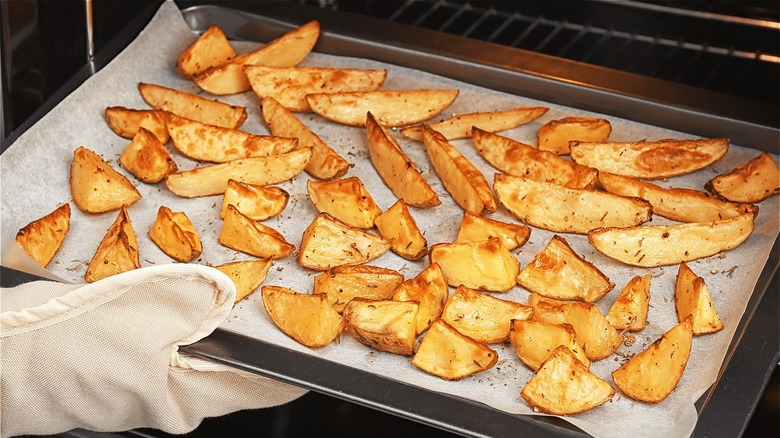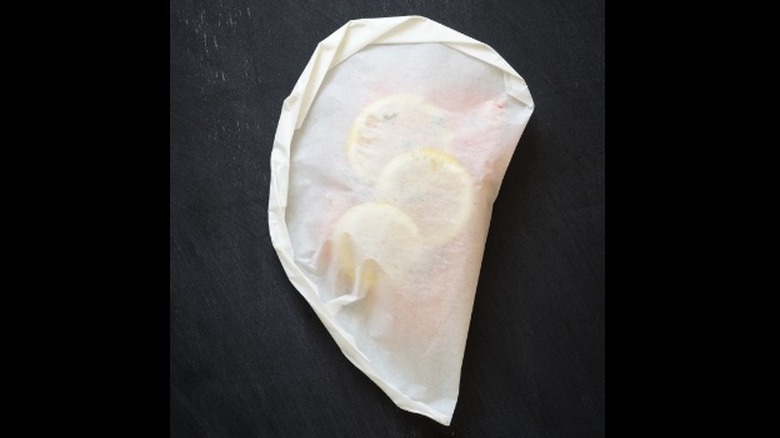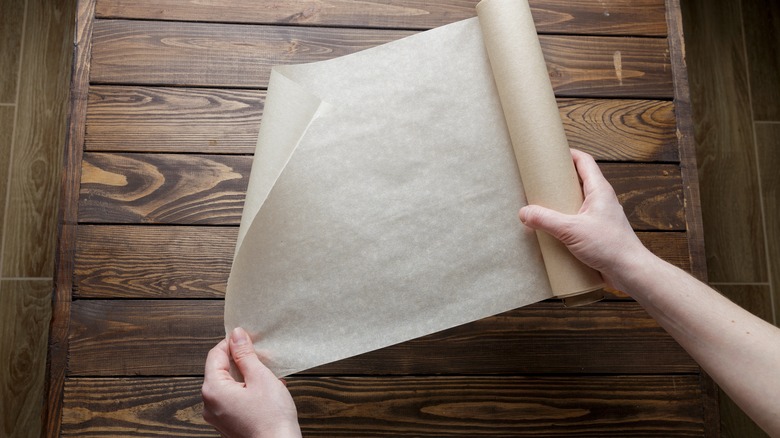Why Foodies Swear By Cooking 'En Papillote'
The story of this cooking method begins in the 1800s with a French chef supposedly hoping to impress his hot air balloonist guest. But it's stuck around over the centuries for one reason: It makes good food great.
En papillote (French for "in parchment") is the non-stick trick of wrapping your food in a makeshift parchment paper pouch to bake. Cooking en papillote keeps your proteins moist and tender, holds in all the flavor of your seasonings, and saves your vegetables from drowning in oil.
For all that, foodies love it. Instagram guru @thekitchette swears by the en papillote method for baking her soy honey garlic salmon to perfection, saying anyone who tries its caramelized, flaky finish will never go another way. Fish is the common en papillote candidate, but you can use the parchment paper pouch for lots more, from basic chicken recipes to specialty ice cream with spicy fruit (although that kind of flair may require an extra en papillote effort, according to Ciaogusto).
How 'en papillote' baking is done
En papillote helps even the incapable cooks among us slam out sumptuous entrées with that "wow" factor. A step-by-step approach to cooking en papillote is to first rip off a sheet of parchment paper and cut it into the shape of a big heart. Then, place your sliced vegetables on the left lobe of your cutout. MasterClass suggests building a tower of veggies, then protein, then adding aromatic elements such as lemon slices or halved cherry tomatoes and spices. Just consider adding a little extra moisture — maybe lemon juice, a splash of your favorite wine, or a bit of olive oil to distribute the flavor evenly throughout the pouch while baking.
Fold the right lobe of your cutout over the left to cover your concoction, then crumple the edges together to seal in moisture. If your parchment folds are fussy and unwinding, Wonder How To suggests brushing a bit of egg wash (egg beaten with water) on your parchment edges to make the pouch stick tight.
Cook times vary slightly depending on recipe, but as a general rule, no baking above 450 F — you'll scorch (more like torch) your parchment. Slit your pouch and enjoy your dinner. Or leave the pouches puffed for your guests to slice open at the table for a collective festive feel. The appreciation from guests is nice but even better is the cleanup that takes tossing a few bags rather than scrubbing a sink full of dishes.
How 'en papillote' originated
How en papillote got its official moniker and claim to fame is multilayered. For starters, The Virginian Pilot says that papillote comes from the French word "papillon" (butterfly), and that parchment cut into two attached circles (food on one side, then fold paper over and crease) looks like butterfly wings. PhilosoKitchen points out that the term "en papillote" is French for "enveloped in paper."
The name is descriptive enough, sure, but the real impresario who raised the visibility of the en papillote method was a French chef who settled in New Orleans, started a restaurant, and in the late 1800s, wanted to impress a special guest. Locals Seafood tells the tale of French Chef Jules Alciatore, who wanted to dazzle visiting guest Alberto Santos-Dumont, the Brazilian aviator who flew the first steerable hot air balloon. Chef Alciatore picked an in-season fresh fish plus a sumptuous creamy sauce (pompano with butter, white wine, shrimp, and lump crabmeat) to treat the balloonist to an entrée packaged and puffed like a pseudo balloon for affect. The Pompano en Papillote has become a storied favorite ever since.
Unlike Chef Alciatore, we mere kitchen-dwelling mortals may fall short on flair and innovation. However, like Chef Alciatore, we who are average can borrow from his genius and other like him, who stick with in-season elements, quality herbs and spices, and then let the en papillote method do the work from there.


